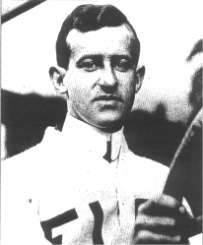Caleb Bragg
Caleb Smith Bragg (23 November 1885 – 24 October 1943) was an American racecar driver, speedboat racer, aviation pioneer, and automotive inventor.[1] He participated in the 1911, 1913 and 1914 Indianapolis 500. In speedboat racing, Caleb won three consecutive APBA Challenge Cup races in Detroit from 1923-1925.[2] He was a co-inventor of the Bragg-Kliesrath brake.[1]
Caleb Smith Bragg | |
|---|---|
 Bragg at the 1912 Indianapolis 500 | |
| Born | November 23, 1885 Cincinnati, Ohio |
| Died | October 24, 1943 (aged 57) Memorial Hospital Manhattan, New York City |
| Occupation | racecar driver |
| Known for | co-inventor of Bragg-Kliesrath brake |
Early life
Bragg was born on November 23, 1885 in Cincinnati, Ohio to Cais C. Bragg and Eugenia Hofer who were wealthy.[3]
Education
While at Yale University he became interested in automobile racing.[3] Bragg graduated from Yale in 1908 and took a post-graduate engineering course at Massachusetts Institute of Technology in 1909.[1]
Career
On October 5, 1912 Bragg driving a 14 liter F.I.A.T. S74 took 1st place at the 1912 American Grand Prize race, the seventh and final race of the 1912 Grand Prix season. It was held at the Wauwatosa Road Race Course in Milwaukee, Wisconsin and was sanctioned by the Automobile Club of America.[4] Caleb Bragg won by over 15 minutes over Erwin Bergdoll and his 9.5 liter 37/90 hp Benz. Bragg's average speed was 68.397 mph (110.074 km/h).[5]
During World War I he became interested in flying airplanes and in 1916 he flew his first solo flight; he later set airplane records for speed and altitude.[3]
Bragg developed a braking system with Victor William Kliesrath called the Bragg-Kliesrath brake. They formed a company in 1920 and Ethel Merman was his personal secretary before she became famous.[3] They sold the company to Bendix Corporation in the late 1920s.[6]
In speedboat racing, Caleb won three consecutive APBA Challenge Cup races in Detroit from 1923-1925, in 1923 with Packard Chriscraft and the 1924-1925 races with Baby Bootlegger, the 29-foot mahogany wooden speedboat designed for him in 1924 by George Crouch and built by Henry Nevins.
Personal life
Bragg died on 24 October 1943 in New York City, New York.[1]
Indy 500 results
|
| |||||||||||||||||||||||||||||||||||||||||||||||||||||||||||
Gallery
 Bragg in his Mercer
Bragg in his Mercer
References
- "Caleb Smith Bragg, Dies. Flier, Auto Racer, Pioneer in Automotive Field. Also Noted as an Inventor and Speedboat Pilot". The New York Times. October 25, 1943. Archived from the original on November 8, 2017. Retrieved 2011-04-23.
Caleb S. Bragg, long a leading figure in the aviation, automobile and motorboat fields, died here on Sunday in Memorial Hospital after a long illness at the age of 56. An engineer and the inventor or co-inventor of many automobile devices, including the widely used Bragg-Kliesrath brake perfected by him and the late Victor W. Kliesrath. Mr. Bragg won fame as a pioneer automobile racing driver, and Army test pilot during the first World War, a champion altitude flier, aviation manufacturing company officer, consulting engineer and amateur sportsman. He resided at 277 Park Avenue and at Montauk Point, L.I.
- "Caleb Smith Bragg". Early Aviators. Archived from the original on 2017-11-08. Retrieved 2011-04-23.
- Kellow, Brian (2008). Ethel Merman : a life. New York: Penguin Books. ISBN 9780143114208.
- Ward, Harry (October 6, 1912). "Young millionaire racing driver is winner of classic". The Washington Times. Archived from the original on 2018-07-31.
- "American Grand Prize". ChampCarStats.com. Archived from the original on 2017-10-10. Retrieved 2010-06-26.
- Schoneberger, L.A. "Pat" Hyland ; edited by W.A. (1993). Call me Pat : the autobiography of the man Howard Hughes chose to lead Hughes Aircraft. Virginia Beach, VA: Donning Co./Publishers. p. 147. ISBN 9780898658736.